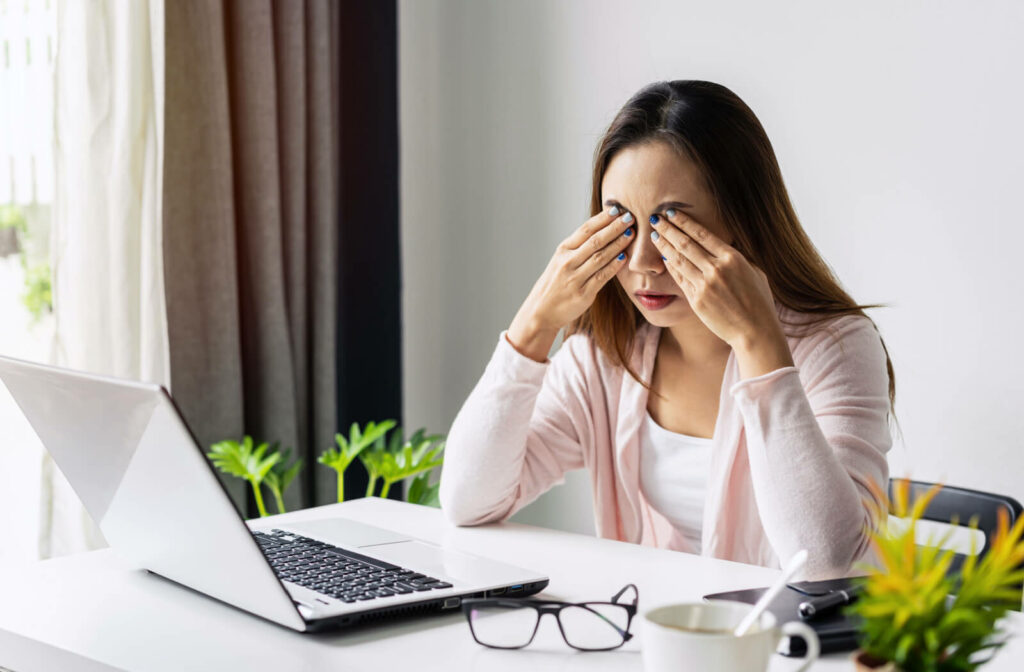Computer Vision Syndrome (CVS), also known as digital eye strain, can be irritating and uncomfortable for those who spend a lot of time in front of screens, especially when it causes symptoms like dry eyes.
While symptoms often go away after you stop using a computer, the specific amount of time that computer vision syndrome lasts can vary based on your eye health and the amount of time you use a computer.
What is Computer Vision Syndrome?
Computer vision syndrome is becoming more and more prevalent with the rise of digital devices, both professionally and personally. It can significantly impact an individual’s comfort, leading to symptoms such as eye strain, headaches, blurred vision, and dry eyes.
The factors that lead to digital eye strain are not isolated to screens. Room lighting and how you set up your workspace can also cause symptoms of computer vision syndrome.
Learning about proper ergonomics when working at a desk and taking frequent breaks when looking at a digital device can help prevent computer vision syndrome.
What are the Symptoms of CVS?
The most common symptoms of CVS are eye strain, headaches, blurry vision, dry eyes, and fatigue. In some cases, it can also lead to neck and back pain. Additionally, people with CVS might experience difficulty focusing and an increased sensitivity to light.
How Long Does CVS Last?
CVS will typically start to go away after your last interaction with your screen. However, if you are consistently experiencing physical discomfort while using technology or dealing with any visual impairment, it’s best to consult a doctor or optometrist to ensure there isn’t something more serious going on.

How to Prevent Computer Vision Syndrome
While CVS can be common among computer users, there are steps you can take to prevent and reduce its symptoms. Let’s explore a few methods to help you avoid computer vision syndrome.
The 20-20-20 Rule
One way to prevent CVS from occurring is called the 20-20-20 rule. This rule encourages people to take a break from their screens every 20 minutes by looking away for at least 20 seconds and focusing on something 20 feet away.
Carrying out this simple exercise each time your eyes begin feeling strained can help keep any potential CVS symptoms at bay.
Eye Drops
Lubricating eye drops and artificial tears can help keep your eyes hydrated, improving overall comfort. However, it is important to note that you should visit your optometry team for an eye exam before using any over-the-counter products, so your optometrist can make sure you are getting an eye drop formulation suitable for your needs.
Environmental & Ergonomic Changes
Another way to prevent and manage CVS is through making simple changes to your environment and ergonomics.
It could be as easy as adding a humidifier to your home office or adjusting the location of your screen, so it’s not in a direct source of wind. Glare on computer screens can also be irritating and difficult for the eyes, so reducing glare can provide relief.
Making mindful changes to your daily routine can help you get more relief from computer vision syndrome.
Preventing and Minimizing Digital Eye Fatigue: Tips for Optimal Vision Health
CVS can be difficult and uncomfortable for those using digital devices frequently.
Of course, prevention helps reduce your need for treatment. For anyone using digital devices regularly, it can be helpful to take regular breaks from screens, reduce your exposure to blue light, and keep your working area well-lit to minimize the effects of CVS.
At Charles Korth Optometry, we are always available to help our customers find a solution that prevents and minimizes digital eye fatigue. If you would like more advice or need information about products that can help reduce digital eye strain, please do not hesitate to contact us!




